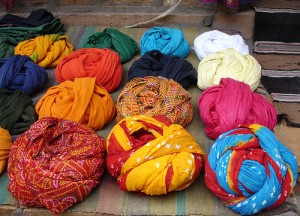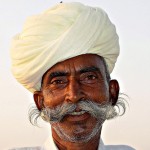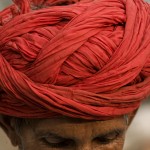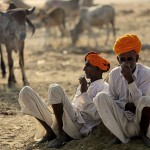 The bright, colorful turbans worn by the men in Rajasthan make for a captivating sight. Known as “pagdis” in local tongues, these turbans reflect the wearer’s cast, culture and profession. Pagdis are extremely popular in the rural areas of the state but sometimes even urban men can be seen wearing them.
The bright, colorful turbans worn by the men in Rajasthan make for a captivating sight. Known as “pagdis” in local tongues, these turbans reflect the wearer’s cast, culture and profession. Pagdis are extremely popular in the rural areas of the state but sometimes even urban men can be seen wearing them.
Mandatory while performing rituals and taking part in traditional ceremonies, turbans are an integral part of Rajasthani culture and setup. They are often visible in paintings and find mention in folk songs, proverbs, stories and literature. Extensive court records from medieval periods speak in great detail about the length, size, material and cost of turbans in Rajasthan. Different types of turbans are used on different occasions. For example, while mourning, turbans with plain or muted colors are worn. Turbans are also gifted to in-laws of a bride during the wedding.
Different communities in Rajasthan usually have their distinct types of turbans. While the Rajputs have their signature five colored turbans, the Jats,  Bishnois and Ram Snehis wear plain white turbans. Raikas and Kabirs are famous for their bright, red turbans, while the sanyasis wear ochre ones. Langa Kalbeliya gypsies prefer colored turbans with check prints, which is commonly associated with the state, in popular culture like movies.
Bishnois and Ram Snehis wear plain white turbans. Raikas and Kabirs are famous for their bright, red turbans, while the sanyasis wear ochre ones. Langa Kalbeliya gypsies prefer colored turbans with check prints, which is commonly associated with the state, in popular culture like movies.
It is even said that a new style of turban emerges with every 15 kilometres you travel in the state. In some areas of the state, it’s the size of the turban which indicates the person’s standing in the society. About 1000 different styles of turbans in Rajasthan have been recorded.
However, a turban is not just ornamental. it also scores high on utility, flexibility and adaptability, especially when compared to other Indian headdresses. It protects the wearer from the scorching Rajasthani sun. Farmers and shepherds can often be seen wearing some of the biggest turbans. There are some practical applications of turban as well. At times, exhausted travellers also use it as a makeshift pillow, a sheet for covering the body and a towel. In fact, turbans can be unknotted and be used as ropes too! For example, they can be used to draw water from wells..
A turban can also be adjusted and worn according to the situation. For example, it can be tied in an easygoing manner if the wearer is at home and it may be tied with much more sophistication during ceremonies and social events.
ceremonies and social events.
Usually, a turban is made from a cloth strip 82 feet long and 8 inches wide. A ‘safa’ on the other hand is shorter but broader. Normally, the common man wears turban of one color, while the elite wear designs and colours according to the occasion. The fabric which is commonly used in the manufacture of Rajasthani turban is muslin. It is lightweight but still voluminous and airy. Cotton is another common choice of fabric for making turbans. The affluent Rajasthanis may also wear turbans made of silk.

Facebook comments: ManaHotels